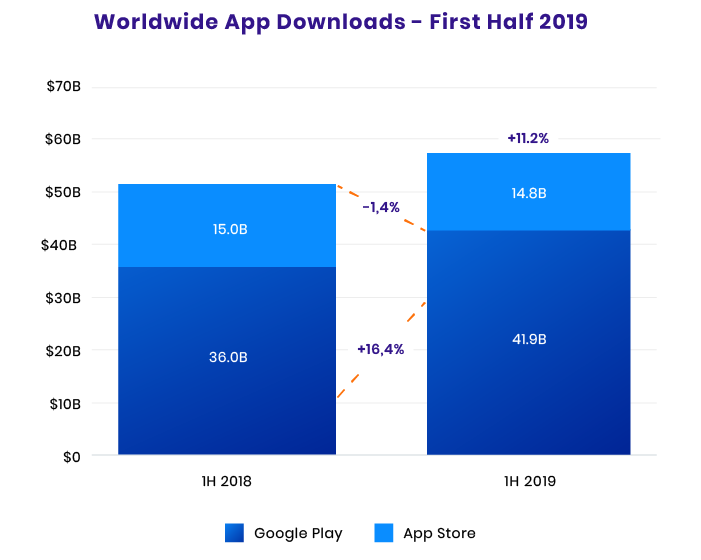How Do Free Mobile Apps Make Money?


Do you have an idea for a free mobile application but you doubt whether it's worth investing? How do free apps make money?
Your doubts are quite clear: the development of a top-notch mobile app requires a lot of time (typically, several months) and, more importantly, money. Before kicking off the development process, you should clearly understand how you’ll recoup your investments and how to make money with apps in 2020 or in the future.
We’ve decided to help you get your idea off the ground and show how exactly you can make money on free apps.
According to Sensotower, the App Store and Google Play users spent a total of $39.7 billion on mobile apps and games during the first half of 2019. This is a huge market you don’t want to miss out on.
If you think that it’s the paid apps that bring the lion’s share of this huge revenue, you’re wrong. In fact, if you check the list of the top grossing mobile applications (including games) in the Google Play Store and the Apple App Store, you’ll notice they’re all free.
The vast majority of users on all continents prefer free mobile applications. In fact, the number of free app downloads is constantly rising. Statistics provided by Sensotower show that in the first half of 2019, free mobile apps downloads in Google Play increased by 16,4 percent and made up $41,9 billion. Whilst the App Store lost 1,4 percent in downloads. However, the overall tendency remains positive.

Image source: Sensotower
Developing a free mobile app is definitely the right business strategy.
Before shedding light on how to make money with apps, we’d like to draw your attention to another matter: correct app presentation. Remember that users must be able to quickly find your app and understand what it’s designed for.
As of the second quarter of 2019, there were 2.46 million apps (of all types) in the Google Play Store and 1.96 million in the Apple App Store. The competition is really strong!
How many users will find your free mobile app? How many of them will download it? No matter how good your app is and what monetization methods you use, you may still fail to attract customers without a clear app packaging.
Potential users of your app should be able to quickly find it through search in the Google Play Store and the Apple App Store. To make your mobile app visible and easy to find, you should provide it with an attention-grabbing name, an informative description, and screenshots
Here are tips that will help you create a top-class app description:
Choose a Clear and Catchy App Name
Your mobile app should have a snappy name that reflects its major functions. Though many applications have names that convey nothing about their functionality, your app is likely to attract a lot more users if it has a name that hints at what it does. It’s particularly useful to include keywords in the app name.
For example, let’s look at Instagram, one of the most popular non-gaming Android apps on the Google Play Store. As you can see, the full title contains an explanation of what this app does (i.e. it offers free content upload and messages):

In general, the name of your app shouldn’t be too long – 20 characters at most. Think carefully about the name, as it’s the first thing people see and pay attention to when they’re considering whether your application is worth downloading.
Come up With an Informative App Description
The next step is to provide your app with a meaningful and informative description.
The first several sentences (up to the “Read More” or “More” buttons) of an app description should give general information and illustrate the app’s main idea. This part mustn’t be long – up to 225 characters. Few people read further, so make sure to tailor this part of the app description to perfection.
Let’s have a look at a great example of a brief yet informative description for "Among Us", a handy planning catch the impostor game to improve your critical thinking & guts feeling that’s available in both Google Play Store & Apple App Store:

Make Eye-Catching App Screenshots
An app’s name and description are important, but users want to know how your app will look on their mobile devices. That’s why you should include several screenshots – and make sure you pick the best.
We recommend that you add some text to your screenshots, describing some functions of your application. Take a look at a screenshot for the Line app on Google Play Store:

As you can see, this screenshot shows that the app can work on smartphones, tablets, and smartwatches.
Now that you know how to package a five-star app, we can move on to explaining the strategies you can leverage to make money on free apps.
Strategy #1: In-App Purchases
In-app purchases is an extremely popular strategy used by thousands of apps in both the Google Play Store and the Apple App Store. In-app purchases allow users to buy something right in the app.
There are three major types of in-app purchases:

Are you considering to implement in-app purchases in your app? We have a great guide on how to build a mobile payment app like Starbucks.
Strategy #2: In-App Ads
Ads are a driving force of the global market. They’re literally everywhere, and mobile apps aren’t an exception. In-app ads are actually tools of affiliate marketing. With in-app ads, you advertise your affiliates’ products (apps, games, etc.) inside your app and get paid if your users interact with those ads.
There are several types of campaigns used in affiliate marketing, so let’s mention the most popular:
If you wish to monetize your application through ads, there are many networks to work with, such as AdMob and Flurry. Most ad networks support apps on iOS and Android, as well as on some other mobile platforms. Also, don’t forget to check what kinds of campaigns they offer, since you need to understand what exactly you’ll be paid for.
There are several ways to display ads in your mobile app:
In-app ads allow you to make money off free apps, but this monetization strategy works well only for applications with big audiences. If your app is a startup, don’t expect it to bring big bucks this way.
Strategy #3: Freemium
To benefit from the freemium monetization strategy, you need a second, paid version of your application. If users like a free version, they’re likely to opt for a paid one that has some extra functions.
With a freemium model, users are typically offered to upgrade an app to a paid version, and if they agree, they’re directed to an app store.
For example, have a look at MX Player, a popular video player available on Google Play. This mobile app has a free version, but it contains ads:

Users are offered a paid version of this app, called MX Player Pro. It’s the same in terms of functionality, but comes without advertising:

This monetization option is quite efficient, but you shouldn’t provide too many functions in your free app; otherwise, few users will shell out for the paid one.
Strategy #4: Sponsorship
Finding a sponsor is a really lucrative monetization model. Usually, it works this way: you create a mobile app that gains quite a lot of users, after which you contact a sponsor company and offer to update the design of your app to match the sponsor’s brand.
There are two types of sponsorship deals: you can either split the revenue with your sponsor or receive a monthly sponsorship fee.
The main difficulty of sponsorship is finding a sponsor. Needless to say, your mobile app should be good enough to be interesting to potential funders.
Strategy #5: Email Marketing
Email marketing has always been and still is a powerful money-making strategy. You can leverage this method and ask the users of your mobile app to provide their emails and, later, send them messages.
Adding a Facebook login option to your free app is a great way to subtly collect user emails. However, give users a chance to cancel email notifications, as this will make your app more credible and people will know they won’t be receiving loads of spam.
ETC Tech is a leading web design company in Malaysia with an extensive portfolio of remarkable results. Our custom web development and mobile app development services aims to help you and your business to grow.
Want to know more? Contact us ;)